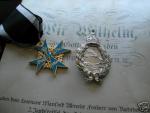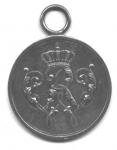-
Posts
785 -
Joined
-
Last visited
-
Days Won
4
Content Type
Profiles
Forums
Blogs
Gallery
Events
Store
Everything posted by Schießplatzmeister
-
Hello again: OK, maybe I am a bit colorblind. For ME, it is a bit difficult to tell based upon the photographs. I am still leaning toward the body of the piece possibly being silver. The lighting here is definately a factor and may add a "yellow" hue to the piece. Some of the photos seem to make the body look gold, and some silver. Oh well, I have been wrong before (as my wife reminds me often). Best regards, "SPM"
-
Hello Carol I: This badge is original and is gold. The center of the piece is of lesser-quality gold or silver-gilt however as it has a slight patinae. Many of these were made this way. The piece is marked with a "W", so it was made by Wagner, Berlin. I have not seen gold badges marked regarding their gold content, however gilded pieces (post~1916) are sometimes marked with the silver content (usually 938). The case is correct as is the ribbon. Best regards, "SPM"
-
Hello Carol I: This is a Baden Order of the Zahringen Lion, Knight II with swords badge. It is original and probably from the 1914-1918 era. The value of the piece would probably be in the area of US$600 to US$750, but prices seem to be going up faster than I can keep track of them! Best regards, "SPM"
-
Dear Sal: I am here to warn you of the dangers you face! Stop collecting now while you have a chance or you will turn out like the rest of us! It gets worse and worse. Soon, you will see your first enamelled Order that you can afford and there will be no turning back! Heed my warning. Best regards, "SPM" All joking aside, this IS an addictive and rewarding hobby. So, welcome and have fun. I hope that you are back now from the "sandbox". Thanks for your service!
-
Dear PKeating: Don't be discouraged! There are a good number of us "sceptics" out there that don't buy all of the hype, because a dealer gives out (sells) certificates of authenticity, or someone declares that they are an expert and writes a book. Human nature being what it is, there will always be an audience for charlitans. Keep speaking the truth as uncomfortable as the feedback may be! My personal maxim is that if one has to explain a great deal about why something is genuine, they are probably trying to convince themselves! Best regards, "SPM"
-

EK 1914 Opinion on 1813 iron cross please
Schießplatzmeister replied to kyokashinkai's topic in Germany: All Eras: The Iron Cross
Hello kyokashinkai: Unfortunately, this piece is NOT a genuine piece issued/manufactured from 1813-1840. In my opinion, this is a 1914 2nd class that has been re-worked to produce a forgery. I would return it ASAP! Best regards, "SPM" -
[attachmentid=61907] Hello everyone: Here is an item from my collection that I believe supports derGeneral's restoration of the bar (with the RAO). I too do not like the idea of just adding any order or medal to a bar, but this combination of awards was probable for this bar originally, so it is not too much of a stretch. Sorry about the black and white scan! My scanner is giving me grief these days. By the way, the 1870 medal in the miniature group is the non-combat (steel/silver coloured) version. Best regards, "SPM"
-
Dear derGeneral: If you have the Crown Order 4th Class w/ Geneva Cross, then you have the toughest piece to find already. You are right, an Original 1870 EKII with original white ribbon with black stripes would be tough to find. The RAO 4th Class will not be difficult to find. The question is how much will it cost? These relatively common crosses seem to have been going up in price very fast lately! Best regards, "SPM"
-
Hello Saschaw: Have you considered that a Prussian Crown Order 4th Class with "Genfer Kreuz" seems like a natural fit for your first group at the second position. Unfortunately, we will never know what could have been at the first position. I definately think that this is an older group (1900-1910) and not WWI-era. Best regards, "SPM"
-
[attachmentid=61663] Finally, the chance that all of us have been waiting for! We are now able to buy v. Richthofen's PLM, PLM document, and Pilot's Badge from a seller who doesn't know what treasures he has! This is only the 4th or 5th time that I have seen it offered. I can't believe that no one else has purchased it yet! The description really has me laughing. The fellow must have a Doctorate of Jurisprudence! "The Pour le Merite medal is Gold plated sliver or silver like metal. The letters look to be gold inlays. It is enameled on both sides and has a ribbon. The pilots badge is made of silver or silver like metal can't be sure, It is solid not the cutout version. Both medals show signes of wear with small surface scratches that can only be seen with a magnifying glass. Both pieces have a high quality heavy Jewelry feel to them. As a bonus I will include the document in the picture. It came with the Pour le merite and it is written German. I suspect that it is a certificate of authenticity or an award document but can't be sure. I have no information as to where or when these items were made." I have a suspicion that they were made last week or so! "SPM"
-
Dear gjw: You have posed an excellent question. This is an area regarding Prussian awards that is often overlooked. To clarify, the Prussian Military Honor Decorations (not the General Honor Decorations) were awarded for circumstances involving personal bravery for enlisted soldiers from 1864 onward. I will mention only the awards after 1864 as prior to this date the award system was a bit more byzantine and it would take a good deal of time to explain the little that I know. For the 1864 campaign, the 1st class (cross) and 2nd class (medal) were awarded to enlisted soldiers for bravery. This happened again during the 1866 campaigns, and then again during the China incursion in 1902 and during the DSWA conflicts. There may also have been some other colonial conflicts where a few awards were made, but I have no specific information regarding these at hand at the moment. The awards were usually made on the black with white stripes "Iron Cross" ribbon, but awards were also made on the white ribbon with black stripes for special (non-combat) circumstances. The first class crosses are especially scarce, while the second class medals are often encountered and actually undervalued for what they represent and due to the relatively few numbers awarded compared to the EK. If you can find an award document for one of the 2nd class awards, you have a real gem! The prices for these have been getting very steep lately. I hope that this information is helpful. Best regards, "SPM"
-
Dear Stijn: What I find fascinating is the document for the F?rstlich Hohenzollersches Ehrenkreuz dritter Klasse m/schw. It refers to the Officer's service in I.R. 40 during WWI and shows an actual award date of October 1933! I have not seen another like this. Very nice! Unfortunately, I have all of the pieces that are offered and will not be spending money to re-unite the group for the sake of history (it would be nice if someone does though). Shame on the greedy seller who doesn't care about the man who received these awards or his legacy. But what about the recipient's heirs who didn't care about Opa's medals and wanted money for a new DVD player/flat screen TV/etc. (they are not blameless either)? Unfortuantely, these objects that we treasure so much are generally not appreciated by many people. In fact, there is still an anti-military stigma in Germany among many of the younger generation who have a strong dislike for things military (a legacy of the post-WWII era). I praise all who collect these items for not what they are worth, but for what they represent; the courage, honor, and duty of generations that are now gone. Best regards, "SPM"
-
Dear Stogieman: What super pieces! I have not seen another cased Saxon Landwehr LS bar either, and the miniature is something that is undoubtedly almost unique. Thanks for showing us these great items! Unfortunately, my technical ability to send scans or photos is still lacking at this time, so I ask that someone else submit another mystery case for our analysis. Best regards, "SPM"
-

EK 1914 Fake EK doc...
Schießplatzmeister replied to Chris Boonzaier's topic in Germany: All Eras: The Iron Cross
Hello Folks: I see that the Togoland document and EKI lot were pulled off of Ebay before they ran their course! Interesting! Maybe the seller is honest and saw this thread. Maybe it shamed him into not offering the item as it hadn't been described as a forgery. He was probably just a middle-man selling the stuff for someone else and wasn't an "expert" as others sometimes claim that they are. In any case, it is good to see this item not be purchased by someone who thought they were buying a rare and genuine item! Caveat Emptor! "SPM" -

EK 1914 Fake EK doc...
Schießplatzmeister replied to Chris Boonzaier's topic in Germany: All Eras: The Iron Cross
Dear Chris: This "beauty" looks very familiar (see page 181 of "The Iron Time")! That one is almost identical, and is marked "DARESSALAM". I always thought that it looked like rubbish, and seeing the this one, I am even more convinced of it being a forgery. It is nice to see someone else who thinks the same way. I feel sorry for the fellow that wants to spent hard-earned money on this one! Best regards, "SPM" -
Hello Wildcard: I recall a group of two ~20mm W?rttemberg campaign (perhaps Paris)/bravery medals in silver. I don't recall specifically which ones as it was some time ago (over 10 years). At first they looked OK, but upon close inspection they were undoubtedly cast forgeries of recent (at that time) manufacture. Best regards, "SPM"
-
Hello folks: Unfortunately Steve, I am with Les on this one. The seller is a known purveyor of counterfeit items. The fact that these have appeared more than once should be an indicator of recent (very recent) manufacture. I years ago saw this individual selling good quality cast copies of very rare miniature Napoleonic campaign medals. Caution should be used by everyone when dealing with this fellow. Best regards, "SPM"





